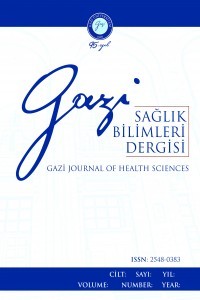Besin Ambalajlarında Sürdürülebilirliğe İlişkin Logo Varlığının İncelenmesi: İtalya Örneği
besin etiketleri, besin logosu, sürdürülebilir beslenme, food labeling, food logos, sustainable nutrition.
EXAMINING THE PRESENCE OF THE LOGO ABOUT SUSTAINABILITY ON FOOD PACKAGES: THE CASE OF ITALY
food labeling, food logos, sustainable nutrition.,
___
- 1. Smetana SM, Bornkessel S, Heinz V. A Path From Sustainable Nutrition to Nutritional Sustainability of Complex Food Systems. Front Nutr. 2019; 6: 39.
- 2. Pekcan AG. Sürdürülebilir Beslenme ve Beslenme Örüntüsü: Bitkisel Kaynaklı Beslenme. Beslenme ve Diyet Dergisi. 2019; 47(2):1-10.
- 3. Grunert KG, Hieke S, Wills J. Sustainability labels on food products: Consumer motivation, understanding and use. Food policy. 2014; 44,177-189.
- 4. Van Looa, EJ., Grebitusc C, Verbeke W. Effects of nutrition and sustainability claims on attention and choice: An eye-tracking study in the context of a choice experiment using granola bar concepts. Food Qual Prefer. 2021; 104100.
- 5. Futtrup R, Tsalis G, Pedersen S, Dean M, Benson T, Aschemann-Witzel J. Is the whole more than the sum of its parts? Challenges and opportunities for a holistic consumer-friendly sustainability label on food. Sustain. Prod. Consum. 2021;1411–1421.
- 6. BDA, 2014. Policy Statement Environmentally Sustainable Diets.
- 7. Swanson KS, Carter RA, Yount TP, Aretz J, Buff PR. Nutritional sustainability of pet foods. Adv Nutr. 2013, 4:141–50.
- 8.Harvard. 2021. “The Nutrition source” https://www.hsph.harvard.edu/nutritionsource/sustainability/ Son erişim tarihi: 31 Mart 2022.
- 9. FAO. 2022. “Food based dietary guidelines”. http://www.fao.org/nutrition/education/food-dietary-guidelines/background/sustainable-dietary-guidelines/en/ Son erişim tarihi: 31 Mart 2022.
- 10. EFAD. 2022. “FAO & WHO Sustainable Healthy Diets Guiding Principles”. http://www.efad.org/en-us/reports-and-papers/other-reports/fao-who-sustainable-healthy-diets-guiding-principles/ Son erişim tarihi: 31 Mart 2022.
- 11. Willett W, Rockström J, Loken B, Springmann M, Lang T, Vermeulen S, et al. Food in the Anthropocene: the EAT–Lancet Commission on healthy diets from sustainable food systems. Lancet. 2019;393:447-92.
- 12. Drewnowski A, Finley J, Hess JM, Ingram J, Miller G, Peters C. Toward Healthy Diets from Sustainable Food Systems. Curr. Dev. Nutr. 2020;4(6).
- 13. Auestad N, Fulgoni VL 3rd. What Current Literature Tells Us about Sustainable Diets: Emerging Research Linking Dietary Patterns, Environmental Sustainability, and Economics. Adv Nutr. 2015;6(1):19–36.
- 14. Fanzo J, Bellows AL, Spiker ML, Thorne-Lyman AL, Bloem MW. The importance of food systems and the environment for nutrition. Am J Clin Nutr. 2020;113(1):7–16.
- 15. Alsaffar AA. Sustainable diets: The interaction between food industry, nutrition, health and the environment. Food sci technol int. 2015;22(2):102–11.
- ISSN: 2548-0383
- Yayın Aralığı: Yılda 3 Sayı
- Başlangıç: 2015
- Yayıncı: Gazi Üniversitesi
Doğaç KARAGÜVEN, İlker ÇETİN, Alper KAYA, Berk GÜÇLÜ, Burak AKAN
Seval AĞAÇDİKEN ALKAN, Özge İŞERİ, Meryem KIRMIZI
Sağlıklı Genç Yetişkinlerde Akıllı Telefon Bağımlılığının Parmak Duyusu Hassasiyetine Etkisi
HEMŞİRELERİN İŞYERİ ŞİDDETİNE MARUZ KALMA DURUMLARI İLE İŞ DOYUMLARI VE İŞTEN AYRILMA EĞİLİMLERİ
Nigar ÜNLÜSOY DİNÇER, Refia Selma GÖRGÜLÜ, Aslıhan BOYACIOĞLU
Multiple Sklerozlu Hastalarda El Mental Rotasyon Görevi
Büsra CANDİRİ, Engin RAMAZANOĞLU, Burcu TALU, Mehmet TECELLİOĞLU
Besin Ambalajlarında Sürdürülebilirliğe İlişkin Logo Varlığının İncelenmesi: İtalya Örneği
Persistent Postural Perceptual Dizziness Tedavisinde Vestibüler Rehabilitasyonun Etkisi
Gebe Kadınların Sağlık Uygulamaları Ve Etkileyen Faktörlerin İncelenmesi
ADÖLESANLARDA KRONOTİPE GÖRE ÖĞÜN ZAMANI VE BESİN TERCİHLERİNİN İNCELENMESİ
